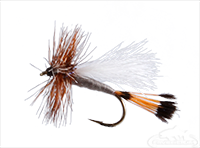Online Fishing stuff
place where you get all stuff for fishing
Welcome to online fishing shop. Here you get best deals for fishing stuff online.
Callibaetis, Parachute, Partridge Post
You found Callibaetis, Parachute, Partridge Post in category and subcategory Brought to you by Online Fishing
Random fishing Flies
|
Copper John, Wired BH, Silver Pink |
|
 Your price: $1.50 |
A popular and effective attrractor nymph pattern, the Silver Pink Wired Bead Head Copper John has taken the fly fishing world by storm. This fly sinks quickly and can be used as a deep nymph or a dropper - fish seem unable to resist the combination of color, flash, and realistic shape. It is best fished where stoneflies and mayflies are found but will work in nearly any situation including Steelhead nymphing and even on lakes. |
|
Trude, Adams |
|
 Your price: $1.50 |
The Adams Trude is a visible fly pattern that will never go out of style. The down wing provides a silhouette that imitates insects like Stoneflies, Caddis and Moths and is easy to see. Trudes work in all types of water but are especially effective in pockets and on small streams. The Adams Trude is a great choice for low light when flies are difficult to see. |




